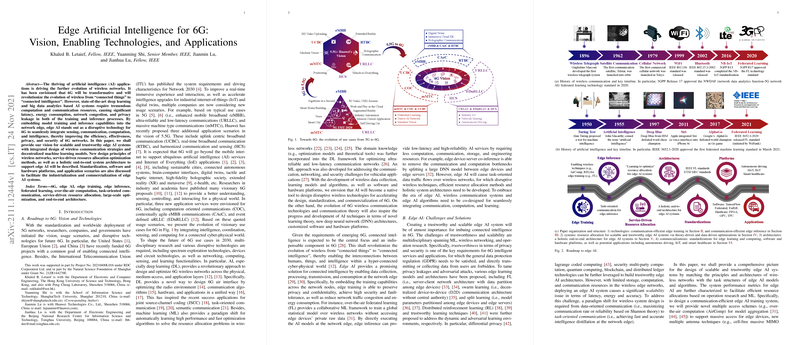Edge AI for 6G: Vision, Technologies, and Applications
The progression of wireless networks towards 6G is poised to be transformative, driven by the extensive integration of AI at the network edge. The paper "Edge Artificial Intelligence for 6G: Vision, Enabling Technologies, and Applications" by Khaled B. Letaief et al. offers an exhaustive examination of how edge AI can revolutionize wireless communications by seamlessly integrating sensing, communication, computation, and intelligence. Through embedding AI capabilities directly into the network architecture, this research articulates a future where intelligence is decentralized, scalable, and trustworthy, addressing both theoretical foundations and practical implementations.
Vision and Enabling Technologies
The authors articulate a vision where 6G shifts from “connected things” to “connected intelligence.” This entails transforming current wireless networks into systems that support ubiquitous AI services and applications, leveraging edge AI to manage tasks that demand rigorous computation and data processing. Critically, edge AI is presented as a disruptive solution addressing latency, energy consumption, congestion, and privacy concerns prevalent in traditional AI systems.
The paper explores several enabling technologies, emphasizing next-generation multiple access schemes such as over-the-air computation (AirComp) and nonorthogonal multiple access (NOMA) which facilitate efficient function computation necessary for AI tasks. The integration of technologies like ultra-massive MIMO, reconfigurable intelligent surfaces (RIS), and space-air-ground integrated networks (SAGIN) represents significant steps towards fulfilling the complex requirements of edge AI in 6G.
Edge AI Systems: Challenges and Solutions
The exploration into edge AI systems outlines two core challenges: trustworthiness and scalability. Through federated learning (FL), the paper presents strategies to preserve privacy and maintain system robustness, utilizing innovative models like over-the-air federated learning and secure aggregation rules. Scalability issues are explored from a resource allocation perspective, focusing on engineering requirements such as minimizing latency, optimizing energy use, and guaranteeing AI task accuracy. The paper’s emphasis on task-oriented communication marks a pivotal turn from data-rate maximization towards task-specific communication efficiency.
Implications and Future Potential
This paper offers a coherent framework connecting theoretical insights with practical implementations to outline the full spectrum of edge AI within 6G. The implications of this research are profound, offering a pathway to more efficient, autonomous networks capable of learning and adapting in real-time, meeting demands for low-latency and high-reliability AI services.
Beyond immediate applications, the potential impact on domains like autonomous driving, industrial IoT, and smart healthcare is immense, facilitating advances from real-time decision making to enhanced privacy-preservation techniques. The prospect of embedding native intelligence and trustworthiness into the foundational structure of 6G networks positions edge AI as fundamental not just technologically but also economically and socially, fostering environments rich with AI-automated interactions.
Conclusion
This paper synthesizes the intricacies of deploying edge AI systems within 6G frameworks, making bold yet substantiated claims about future network capabilities. By focusing on robust wireless communication strategies and resource allocation designs, the paper provides clear directions for ongoing research and industrial application. Ultimately, the authors argue convincingly for a vision whereby edge AI catalyzes a new era in wireless networks, shaping not just the technology but the experience of connectivity. The sophisticated exploration opens pathways for richer, smarter, and more secure networks, heralding a fundamental shift towards the intelligent landscapes of future communications.
